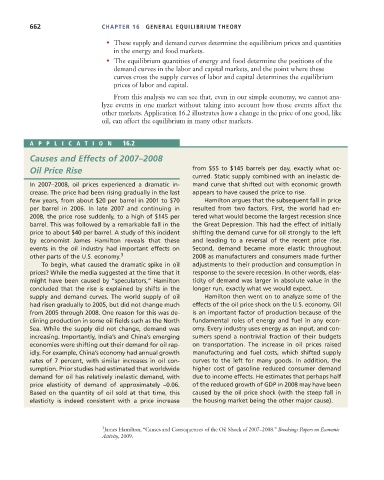Page 688 - Microeconomics, Fourth Edition
P. 688
c16GeneralEquilibriumTheory.qxd 8/16/10 9:13 PM Page 662
662 CHAPTER 16 GENERAL EQUILIBRIUM THEORY
• These supply and demand curves determine the equilibrium prices and quantities
in the energy and food markets.
• The equilibrium quantities of energy and food determine the positions of the
demand curves in the labor and capital markets, and the point where these
curves cross the supply curves of labor and capital determines the equilibrium
prices of labor and capital.
From this analysis we can see that, even in our simple economy, we cannot ana-
lyze events in one market without taking into account how those events affect the
other markets. Application 16.2 illustrates how a change in the price of one good, like
oil, can affect the equilibrium in many other markets.
APPLICA TION 16.2
Causes and Effects of 2007–2008
Oil Price Rise from $55 to $145 barrels per day, exactly what oc-
curred. Static supply combined with an inelastic de-
In 2007–2008, oil prices experienced a dramatic in- mand curve that shifted out with economic growth
crease. The price had been rising gradually in the last appears to have caused the price to rise.
few years, from about $20 per barrel in 2001 to $70 Hamilton argues that the subsequent fall in price
per barrel in 2006. In late 2007 and continuing in resulted from two factors. First, the world had en-
2008, the price rose suddenly, to a high of $145 per tered what would become the largest recession since
barrel. This was followed by a remarkable fall in the the Great Depression. This had the effect of initially
price to about $40 per barrel. A study of this incident shifting the demand curve for oil strongly to the left
by economist James Hamilton reveals that these and leading to a reversal of the recent price rise.
events in the oil industry had important effects on Second, demand became more elastic throughout
other parts of the U.S. economy. 3 2008 as manufacturers and consumers made further
To begin, what caused the dramatic spike in oil adjustments to their production and consumption in
prices? While the media suggested at the time that it response to the severe recession. In other words, elas-
might have been caused by “speculators,” Hamilton ticity of demand was larger in absolute value in the
concluded that the rise is explained by shifts in the longer run, exactly what we would expect.
supply and demand curves. The world supply of oil Hamilton then went on to analyze some of the
had risen gradually to 2005, but did not change much effects of the oil price shock on the U.S. economy. Oil
from 2005 through 2008. One reason for this was de- is an important factor of production because of the
clining production in some oil fields such as the North fundamental roles of energy and fuel in any econ-
Sea. While the supply did not change, demand was omy. Every industry uses energy as an input, and con-
increasing. Importantly, India’s and China’s emerging sumers spend a nontrivial fraction of their budgets
economies were shifting out their demand for oil rap- on transportation. The increase in oil prices raised
idly. For example, China’s economy had annual growth manufacturing and fuel costs, which shifted supply
rates of 7 percent, with similar increases in oil con- curves to the left for many goods. In addition, the
sumption. Prior studies had estimated that worldwide higher cost of gasoline reduced consumer demand
demand for oil has relatively inelastic demand, with due to income effects. He estimates that perhaps half
price elasticity of demand of approximately –0.06. of the reduced growth of GDP in 2008 may have been
Based on the quantity of oil sold at that time, this caused by the oil price shock (with the steep fall in
elasticity is indeed consistent with a price increase the housing market being the other major cause).
3 James Hamilton, “Causes and Consequences of the Oil Shock of 2007–2008.” Brookings Papers on Economic
Activity, 2009.

